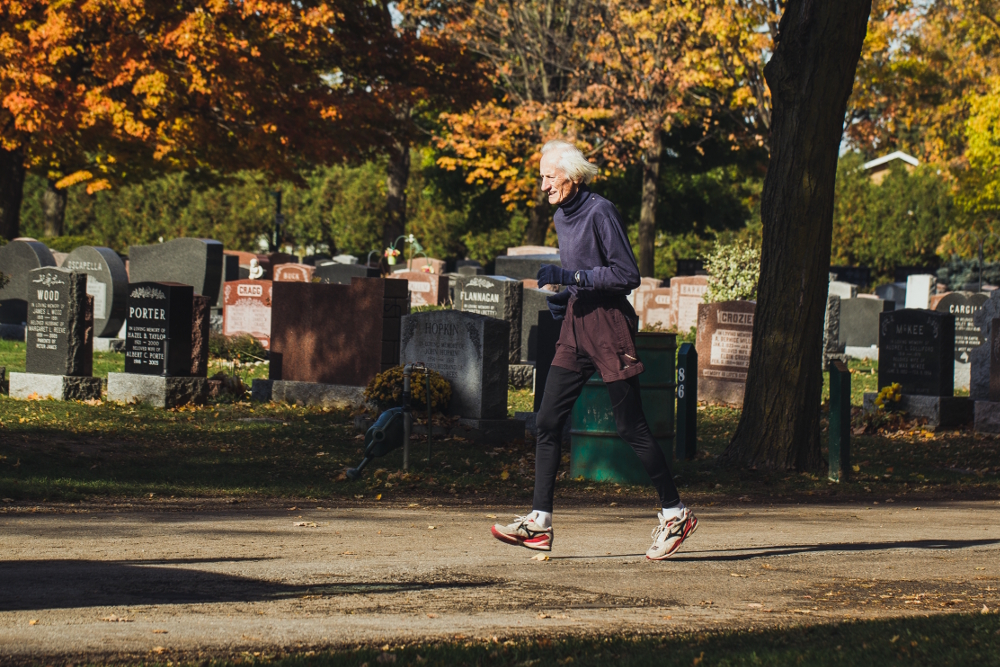I have always found something beautiful about running in a cemetery–the wind in my hair, the sprawling grass fields, and the silence around me. That is until one day when I ran straight into a funeral procession.
It was a sunny April morning in Vancouver. I had decided to embark on a new route through a wooded cemetery. After sprinting down a winding path, I was unexpectedly met with a dozen tearful eyes. They belonged to a family in mourning, standing above an open grave. One of them let out a long cry. The bagpiper stopped playing—talk about dead silence. Embarrassed, I retreated up the path like Homer Simpson, fading backward into a bush.
That’s when I began to wonder: is it wrong to run in a cemetery? More broadly, how do we balance our personal freedom with respect for the dead and their loved ones?

Turning back the clock
The history of Canadian cemeteries can be traced back to Indigenous burial sites from the 16th century, often in areas of spiritual significance. These were not just resting places for the deceased but also served as communal spaces for the living, where ceremonies and rituals were held.
Church graveyards, a later development, were established beyond church grounds and were symbolic of religious influence. In the 19th century, as urbanization increased and there was a need for more space, public cemeteries were established, serving as spaces for remembrance, reflection and respect.
By the 21st century, the concept of cemetery burials had declined. Today, cremation has become the dominant choice for the deceased, mainly due to its lower cost. As of 2022, 74.4 per cent of deaths in Canada resulted in cremation. This shift in burial practices raises questions about the future of cemeteries and the potential for repurposing these spaces for other uses.

Prioritizing the living
Mount Pleasant Cemetery in Toronto is an example of a cemetery embracing changing times. Despite its signs advising cyclists not to race, its website proudly states: “For those who like to walk or jog through the cemetery, we have created some 1 KM, 3 KM, and 5 KM routes.” They even attach maps showing these routes for runners’ use. That being said, it is rumored that some run clubs have been asked not to train in the cemetery because the noise and activity of a group of joggers might disturb those mourning or visiting graves.
Green spaces account for just 13 per cent of Toronto’s total land, making cemeteries an attractive alternative to racing along the bustling intersections of the city’s downtown core. One study in Canadian Science Publishing argues that since most Canadian cities have limited green space (open space with urban vegetation), cemeteries should be places where residents can enjoy their many benefits.

These benefits include improvements to physical health from outdoor exercise and mental health from peaceful surroundings like nature. For many, running in a cemetery offers a unique blend of tranquillity and natural beauty that is hard to find in urban settings.
Between life and death
Today, more cemeteries appear to be opening their gates to community members. Avondale Cemetery, a municipal cemetery in Stratford, Ont., has struck a good balance between respect and recreational use. Locals affectionately call it a “living cemetery,” where it appears to be more populated by the living than the dead. With the majority of the city above the age of 65, the community is devoted to its graves, some attending to them daily.

During the pandemic, the cemetery became a hot spot for dog walkers, young parents, and runners—even more congested than sidewalks. With a steep hill just beyond its gates, Avondale Cemetery remains a popular spot for runners to hill train. Still, locals stress that it is first and foremost a resting place for the deceased, and ensure it remains respected.
Treading carefully
While cemeteries can be a solace for some, it’s crucial to consider the potential conflicts between these uses and respect for the dead and their loved ones. As runners and visitors to these spaces, we are responsible for ensuring they are treated with the respect they deserve. This delicate balance requires us to tread lightly and remind ourselves why cemeteries exist.

